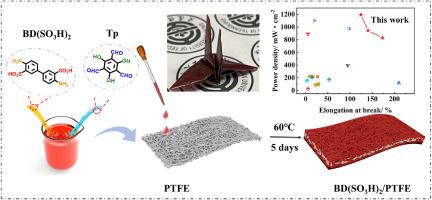用聚四氟乙烯增强的高柔性 SCOF 质子交换膜可提高燃料电池功率密度
IF 9
1区 工程技术
Q1 ENGINEERING, CHEMICAL
引用次数: 0
摘要
磺化共价有机框架(SCOFs)通过密集有序的磺酸基团促进质子快速传导,然而 COFs 自支撑膜的脆性往往给燃料电池组装带来潜在困难,并限制了其功率密度。本文通过在多孔聚四氟乙烯网络中原位生长连续的 BD(SO3H)2-COF 微相,开发出一种高柔性 SCOF 质子交换膜。聚四氟乙烯和 BD(SO3H)2-COF 之间的强氢键促成了 BD(SO3H)2/PTFE 膜的无缺陷形态。聚四氟乙烯网络的加强使膜具有极高的柔韧性,即使 SCOF 的质量比例高达 90 wt%(BD(SO3H)2/PTFE-0.9),断裂伸长率也能达到 124.4%。这使得膜即使在干燥状态下也能反复折叠。即使在离子交换容量高达 3.6 mmol g-1 和吸水率高达 68.2 % 的情况下,80 °C 时在水中的膨胀率也被有效限制在 8.6 %。连续 BD(SO3H)2-COF 微相中密集有序的磺酸基团使得质子电导率在 80 °C 时高达 249.2 mSꞏcm-1,约为 Nafion 212 的 1.5 倍。因此,BD(SO3H)2/PTFE-0.9 膜在 80 °C 时的燃料电池功率密度达到 1195.3 mWꞏcm-2,开路电压高达 1.01 V,超过了最先进的基于 COF 的质子交换膜。这项研究为将 COF 制成灵活、尺寸可扩展的膜提供了一种新策略,从而提高了燃料电池的性能。本文章由计算机程序翻译,如有差异,请以英文原文为准。

Highly flexible SCOF proton exchange membrane reinforced with PTFE to enhance fuel cell power density
Sulfonated covalent organic frameworks (SCOFs) facilitate rapid proton conduction through densely ordered sulfonic acid groups, however, the brittleness of COFs self-supporting membranes often makes potential difficulty in fuel cell assembly and limits their power density. Herein, a highly flexible SCOF proton exchange membrane is developed through in-situ growth of a continuous BD(SO3H)2–COF microphase within porous PTFE networks. The strong hydrogen bonding between PTFE and BD(SO3H)2–COF contributes to the defect-free morphology of the BD(SO3H)2/PTFE membrane. The reinforce of PTFE network makes the membrane extremely high flexibility, achieving an elongation at break of 124.4 % even with a remarkably high SCOF mass proportion of 90 wt% (BD(SO3H)2/PTFE-0.9). This allows the membrane to be folded repeatedly, even in dry state. The swelling ratio in water at 80 °C is effectively restricted to 8.6 %, even with a high ion exchange capacity of 3.6 mmol g−1 and a water uptake of 68.2 %. The densely ordered sulfonic acid groups in continuous BD(SO3H)2–COF microphase contribute to a high proton conductivity up to 249.2 mSꞏcm−1 at 80 °C, approximately 1.5 folds that of Nafion 212. As a result, the BD(SO3H)2/PTFE-0.9 membrane achieves a fuel cell power density of 1195.3 mWꞏcm−2 at 80 °C, along with a high open circuit voltage of 1.01 V, surpassing the-state-of-the-art COF-based proton exchange membranes. This work provides a novel strategy to fabricate COFs into flexible and size scalable membranes, enhancing the performance of fuel cells.
求助全文
通过发布文献求助,成功后即可免费获取论文全文。
去求助
来源期刊

Journal of Membrane Science
工程技术-高分子科学
CiteScore
17.10
自引率
17.90%
发文量
1031
审稿时长
2.5 months
期刊介绍:
The Journal of Membrane Science is a publication that focuses on membrane systems and is aimed at academic and industrial chemists, chemical engineers, materials scientists, and membranologists. It publishes original research and reviews on various aspects of membrane transport, membrane formation/structure, fouling, module/process design, and processes/applications. The journal primarily focuses on the structure, function, and performance of non-biological membranes but also includes papers that relate to biological membranes. The Journal of Membrane Science publishes Full Text Papers, State-of-the-Art Reviews, Letters to the Editor, and Perspectives.
 求助内容:
求助内容: 应助结果提醒方式:
应助结果提醒方式:


